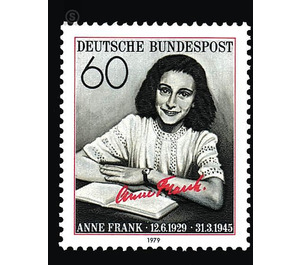50th birthday from Anne Frank - Germany / Federal Republic of Germany 1979 - 60 Pfennig
Theme: Art & Culture
| Country | Germany / Federal Republic of Germany |
| Issue Date | 1979 |
| Face Value | 60.00 |
| Color | black grey |
| Perforation | K 13 3/4: 14 |
| Printing Type | Photogravure 3-color |
| Stamp Type | Postage stamp |
| Item Type | Stamp |
| Chronological Issue Number | 900 |
| Chronological Chapter | GER-BRD |
| SID | 685124 |
| In 61 Wishlists | |
Anne Frank was born on June 12, 1929 in Frankfurt am Main as the second daughter of the banker Otto H. Frank and his wife Edith, b. Dutchman, from Aachen, born. The parents were both from liberal Jewish families. When Hitler came to power in 1933 and National Socialism began to show his true face and anti-Jewish sentiment, it soon became clear to Otto Frank that there could be no future for him and his family in this Germany. When he then had the opportunity to take over a managerial position in Amsterdam, he emigrated with his family to Holland. There, Anne and her sister Margot spent carefree youth. Anne attended the Montessori School, now named Anne Frank School. When the German troops invaded Holland in May 1940, the time of danger broke again for those who thought they had found a safe haven there. Gradually, anti-Jewish laws came out, which made life difficult for the Jewish population. From June 1941 raids were carried out, with Jews arrested on the street and sent to concentration camps where they perished. The life of all Jews was threatened. Since Mr. Frank saw no other way to protect his family, he together with his loyal employees, the plan to set up a suitable hiding place in the rear building of his office building Prinsengracht 263 in order to submerge there in due course. This was big enough to accommodate also his business friend Mr. van Daan with wife and son. Later, a family-known dentist should be admitted. When, on July 5, 1942, Margot called for getting ready to leave for a work camp in Germany, the family went underground the next day. Anne had been given a diary on her thirteenth birthday, which she took to the hiding place. She had to renounce everything that makes up the life of a normal child, school, friends, amusements. So she considered her diary as her intimate friend, to whom she could confide everything. During the 25 months she had to live in the back house, she described truthfully all the events of living together and much that happened in occupied Holland and in the theaters of war. By being completely isolated from the outside world, she developed much faster than would have been the case in normal life. She confided in her diary her deepest thoughts and feelings, which she hid from her surroundings. Despite the difficult situation she was in, she did not lose her idealism and wrote on July 15, 1944: "It is a miracle that I have not given up all my hopes because they seem absurd and unattainable. But I stick to it, in spite of everything, because I still believe in the good in man ... In the meantime, I must uphold my ideals, in the times that come, they may then still be executable. "On 4 August In 1944, when the Allied armies were approaching Holland, the submerged were arrested by the German police and deported to Auschwitz on the last transport (September 3). At the end of October, Margot and Anne were sent on to Bergen-Belsen, where both died shortly after March 1973 of exhaustion and typhoid fever. Otto Frank has experienced the liberation by Russian troops in Auschwitz. When he returned to Amsterdam in June 1945, Miep, one of the loyal helpers, gave him Anne's notes, which had remained as worthless papers in the rear building. Anne's diary is now in over 50 countries, resp. Languages have been published and its effects, as well as those of the play and the film for which it was based, were and are still very strong. Especially the youth have hope for a better world, and she admires Anne's courage, her optimism, her faith and her love of peace and takes her as a role model. The house Prinsengracht is now the seat of the Anne Frank Foundation. Aside from the preservation of the building, she wants to draw the attention of the visitors to the happenings during the dark years of the Second World War and the persecution of the Jews in the sense of Annes Diary. She also works through exhibitions, courses and educational projects against discrimination, prejudice and oppression in the world. (Text: Anne Frank Foundation, Amsterdam)


